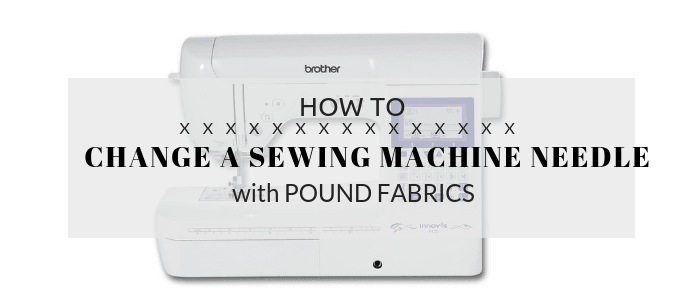
Changing your needle may seem a little daunting - but really is an essential skill you need to learn when sewing. This is because a blunt or broken needlecan not only damage your fabric, but also your machine. A blunt needle may also cause your thread to tangle or your machine to drop stitches - so if you are experiencing these problems, it may be a good idea to change your needle! This guide is designed to make the process as simple as possible, and help you resolve any issues that may lead to a blunt or broken needle.
As a rule of thumb, it is a good idea to change your needle every 5-10 hours sewing or every two projects, regardless of whether the needle has snapped or if you feel it has become blunt. This means you will nearly always start a new project with a fresh, sharp needle and prevents any damage to your machine that a blunt needle can cause, such as damage to the bobbin case or eventual snapping of the needle – this can potentially throw out the stitch timing of your machine. If you find that you are experiencing a lot of problems with your needle, it may be best to get your machine professionally serviced.
There are many different types of needle which can be suitable for your machine. Depending on your project, you may require a special needle, such as a jersey/stretch needle or a denim needle. Usually, it is best to use a universal needle if you are not doing any kind of specialist sewing on a project. It is important to identify whether your machine requires a round or flat shank needle, and it will say in your instruction manual which to use.
You Will Need:
- A sewing machine
- A new needle
----------------------------------------------------------
- Hold the needle in your left hand and undo the screw which lies at the top of the needle with your right hand. Holding the needle means it won't drop down into your machine or onto the floor - this is especially important if your needle is broken. Sometimes your machine will come with a screwdriver that will help you undo the screw.
- Remove the needle by pulling it down and out of the clamp it usually sits in.
- Insert your new needle, with the flat side of the needle shank facing towards the back of the sewing machine. Do this by re-inserting the needle into the clamp with your left hand, as high as it will go.
- Re-tighten the screw with your right hand to hold the needle in place. Do not over-tighten this, as it will be difficult next time you want to change the needle - but also do not leave it too loose, as this may mean the needle is left in the fabric while you sew.
- Rethread your needle as per your machine’s specific instructions.
YOU ARE NOW READY TO SEW!

As you can see, changing your needle can actually be quite simple, as long as you don't wait for it to break or blunt too severely! It may seem a little wasteful changing your needle so often, but it will give you the most professional results. If you are worried about wasting needles, keep any blunter, used needles in a separate tin or pin-cushion, as spares to use in a pinch - only do this if you find you are religiously changing your needles after 5-10 hours of sewing!
To see our full range of fabrics, please click here.
Make sure to tag us @poundfabrics and show us your creations on Instagram, Facebook and Twitter!
Copyright © 2019 Pound Fabrics. All Rights Reserved











Leave a comment (all fields required)